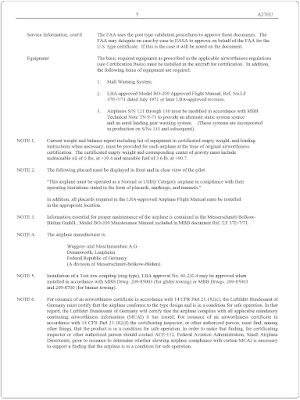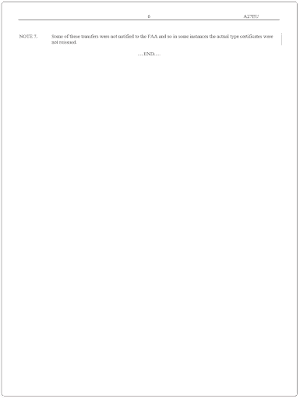Aeronautical publications are the sources of information for guiding aviation mechanics in the operation and maintenance of aircraft and related equipment. The proper use of these publications greatly aid in the efficient operation and maintenance of all aircraft. These include manufacturers’ SBs, manuals, and catalogs; FAA regulations; ADs; advisory circulars (ACs); and aircraft, engine, and propeller specifications.
RELATED POSTS
Manufacturer’s Publications
Aircraft manufacturers provide various manuals with their pro ducts to assist technicians in inspection, maintenance, and repair. With few exceptions , manufacturer's manuals are acceptable data. The technician must use manufacturer's maintenance manuals when performing maintenance.
Manufacturers’ Service Bulletins/Instructions
Service bulletins or service instructions are two of several types of publications issued by airframe, engine, and component manufacturers. The bulletins may include: purpose for issuing the publication; name of the applicable airframe, engine, or component; detailed instructions for service, adjustment, modification or inspection, and source of parts, if required; and estimated number of man-hours required to accomplish the job.
Maintenance Manual
The manufacturer’s aircraft maintenance manual contains complete instructions for maintenance of all systems and components installed in the aircraft. It contains information for the mechanic who normally works on components, assemblies, and systems while they are installed in the aircraft, but not for the overhaul mechanic. A typical aircraft maintenance manual contains:
- A description of the systems (i.e., electrical, hydraulic, fuel, control)
- Lubrication instructions setting forth the frequency and the lubricants and fluids that are to be used in the various systems
- Pressures and electrical loads applicable to the various systems
- Tolerances and adjustments necessary to proper functioning of the airplane
- Methods of leveling, raising, and towing
- Methods of balancing control surfaces
- Identification of primary and secondary structures
- Frequency and extent of inspections necessary to the proper operation of the airplane
- Special repair methods applicable to the airplane
- Special inspection techniques requiring x-ray, ultrasonic, or magnetic particle inspection
- A list of special tools
Overhaul Manual
The manufacturer’s overhaul manual contains brief descriptive information and detailed step-by-step instructions covering work normally performed on a unit that has been removed from the aircraft. Simple, inexpensive items, such as switches and relays where overhaul is uneconomical, are not covered in the overhaul manual.
Structural Repair Manual
The structural repair manual contains the manufacturer’s information and specific instructions for repairing primary and secondary structures. Typical skin, frame, rib, and stringer repairs are covered in this manual. Also, included are material and fastener substitutions and special repair techniques.
Illustrated Parts Catalog
The illustrated parts catalog presents component breakdowns of structure and equipment in disassembly sequence. Also, included are exploded views or cutaway illustrations for all parts and equipment manufactured by the aircraft manufacturer.
Wiring Diagram Manual
The wiring diagram manual is a collection of diagrams, drawings, and lists that define the wiring and hook up of associated equipment installed on airplanes. The data is organized in accordance with the Air Transport Association A4A iSPec 2200 specification.
Code of Federal Regulations (CFRs)
The Code of Federal Regulations (CFRs) were established by law to provide for the safe and orderly conduct of flight operations and to prescribe airmen privileges and limitations. A knowledge of the CFRs is necessary during the performance of maintenance, since all work done on aircraft must comply with CFR provisions.
Airworthiness Directives (ADs)
A primary safety function of the FAA is to require correction of unsafe conditions found in an aircraft, aircraft engine, propeller, or appliance when such conditions exist and are likely to exist or develop in other products of the same design. The unsafe condition may exist because of a design defect, maintenance, or other causes. Title 14 of the CFR part 39, Airworthiness Directives, defines the authority and responsibility of the administrator for requiring the necessary corrective action. The ADs are published to notify aircraft owners and other interested persons of unsafe conditions and to prescribe the conditions that the product may continue to be operated. Furthermore, these are federal aviation regulations and must be complied with unless specific exemption is granted.
There are two categories of ADs:
- Those of an emergency nature requiring immediate compliance upon receipt.
- Those of a less urgent nature requiring compliance within a relatively longer period of time.
Also, ADs may be a one-time compliance item or a recurring item that requires future inspection on an hourly basis (accrued flight time since last compliance) or a calendar time basis.
The contents of ADs include the aircraft, engine, propeller, or appliance model and serial numbers affected. Also, included are the compliance time or period, a description of the difficulty experienced, and the necessary corrective action.
Type Certificate Data Sheets (TCDS)
The type certificate data sheet (TCDS) describes the type design and sets forth the limitations prescribed by the applicable CFR part. It also includes any other limitations and information found necessary for type certification of a particular model aircraft. [Figure 1]
 |
| Figure 1. Type certificate data sheet (TCDS) |
 |
| Figure 1. Type certificate data sheet (TCDS) (continued) |
 |
| Figure 1. Type certificate data sheet (TCDS) (continued) |
 |
| Figure 1. Type certificate data sheet (TCDS) (continued) |
 |
| Figure 1. Type certificate data sheet (TCDS) (continued) |
 |
| Figure 1. Type certificate data sheet (TCDS) (continued) |
All TCDS are numbered in the upper right corner of each page. This number is the same as the type certificate number. The name of the type certificate holder, together with all of the approved models, appears immediately below the type certificate number. The issue date completes this group. This information is contained within a bordered text box to set it off.
The TCDS is separated into one or more sections. Each section is identified by a Roman numeral followed by the model designation of the aircraft that the section pertains. The category or categories that the aircraft can be certificated in are shown in parentheses following the model number. Also, included is the approval date shown on the type certificate.
The data sheet contains information regarding:
- Model designation of all engines that the aircraft manufacturer obtained approval for use with this model aircraft.
- Minimum fuel grade to be used.
- Maximum continuous and takeoff ratings of the approved engines, including manifold pressure (when used), rotations per minute (rpm), and horsepower (hp).
- Name of the manufacturer and model designation for each propeller that the aircraft manufacturer obtained approval is shown together with the propeller limits and any operating restrictions peculiar to the propeller or propeller engine combination.
- Airspeed limits in both miles per hour (mph) and knots.
- Center of gravity (CG) range for the extreme loading conditions of the aircraft is given in inches from the datum. The range may also be stated in percent of mean aerodynamic chord (%MAC) for transport category aircraft.
- Empty weight center of gravity (EWCG) range (when established) is given as fore and aft limits in inches from the datum. If no range exists, the word “none” is shown following the heading on the data sheet.
- Location of the datum.
- Means provided for leveling the aircraft.
- All pertinent maximum weights.
- Number of seats and their moment arms.
- Oil and fuel capacity.
- Control surface movements.
- Required equipment.
- Additional or special equipment found necessary for certification.
- Information concerning required placards.
It is not within the scope of this handbook to list all the items that can be shown on the TCDS. Those items listed above serve only to acquaint aviation mechanics with the type of information generally included on the data sheets. TCDS may be many pages in length.
When conducting a required or routine inspection, it is necessary to ensure that the aircraft and all the major items on it are as defined in the TCDS. The inspector ensures that all installed aircraft equipment conforms to the TCDS. This is called a conformity check and verifies that the aircraft conforms to the specifications of the aircraft as it was originally certified. Sometimes alterations are made that are not specified or authorized in the TCDS. When that condition exists, a supplemental type certificate (STC) is issued. STCs are considered a part of the permanent records of an aircraft and should be maintained as part of that aircraft’s logs.
